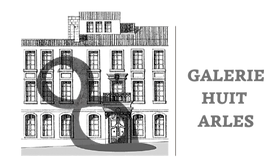Mark Blezinger - MARK‘S WUNDERKAMMER III
Vernissage Saturday 17 September, 18h - 20h
Exhibition from 17 September to 30 october, 2022
Thursday – Sunday, 15h – 18h, and by appointment.
Exhibition of lenticular photographs and optical creations by Mark Blezinger
German photographer and filmmaker Mark Blezinger is inspired by the soul of particular places to create his cabinets of curiosities made of pre-cinema devices that integrate today's digital images. After "Wunderkammer Engadin" where he planted his first imaginary garden in the baroque rooms of the Chesa Planta in Samedan, Switzerland, followed by a second one in the former hunting lodge Scloss Lautrach in Bavaria, Julia de Bierre invites the artist to present a selection of his "Wunderkammer" ( Chamber of Marvels ) at Galerie Huit Arles within the framework of the Festival été indien(s) d'Arles, 2022.
In the salons of this 17th century mansion, the artist plays with the concept of family portraits and landscapes, integrating them in a contemporary way with the period décor. Ephemeral windows open up thanks to the third dimension of lenticular photographic images, a time tunnel between the past and the future….
Thanks to optical illusions lenticular photography allows for 3D vision without glasses.
Since 2005 Mark Blezinger has been creating photographic compositions with Alioscopy: a technology mixing 60 or more view points in a single 3D image, shot on light-sensitive film to obtain a unique depth of vision quality. His extraordinary art works have been presented at numerous contemporary art fairs and in international galleries.

©Mark Blezinger, Nella cattedrale, 2006,
.jpg)
About the Artist
Mark Blezinger, photographer and director.
Born in Baden-Baden in 1962, he studied theater and philosophy in Paris and trained as a
director and actor. For several years he worked at the Schaubühne am Lehniner PLatz,
Berlin, where he was assistant to directors such as Luc Bondy, Klaus-Michael Grüber, Peter
Stein, Andrzej Wajda or Bob Wilson. These varied aesthetic worlds have taught him multiple
forms of theatrical art.
Since 1989 he has been living in Paris, working internationally as a visual artist.
He founded the Béla Compagnie in 1995 with which he produces numerous projects as
artistic director.
Positions:
Director for the Festival d'Automne in Paris and the Festival d'Avignon.
Head of the cultural program of the Goethe-Institut Paris.
Director of documentary films for the French-German channel Arte, director and set
designer fof numerous projections in theatrical and operatic productions, photographer working with the lenticular technology of Alioscopy.
Artistic director of the cultural cycle AlpenMythenSehen with Dora Lardelli,
President of the Cultural Archives of the Upper Engadine in 2013.
Exhibitions in galleries and art fairs (selection):
Art Athina, Athens,Butterfly Castle of Arts, St. Moritz. Espace Cardin-Théâtre de la Ville,
Paris, Estampa, Madrid, Goldbachzentrum, Küsnacht, Hammer Gallery, Scope, Art Basel,
Kunstraum 2art, Samedan, Paris Photo, Parkhotel Margna, Sils-Baselgia, Switzerland,
Rencontres photographiques d'Arles, Rimessa Castelmur, Bergell, Switzerland, Schloss
Lautrach, Germany, Scheublein Fine Art, Castle Sihlberg, Zurich, Center for Arts and Media
(ZKM), Karlsruhe.
Multimedia installations in festivals, museums, public places: Cultural Archives of the Upper
Engadine, Chesa Planta, Samedan (Swiss Prize for the protection of cultural 2013, Marseille
European Capital of Culture 2013, Maloja Palace, Festival dell'Arte Palace, Festival dell'Arte
Bregaglia, Pretorio, Vicosoprano, Palazzo Salis, Soglio, 2014, Festa Segantini, Parc Ela,
Savognin, Switzerland, 2015, Musée des Merveilles, Tende, France 2016, Forum Paracelsus,
St. Moritz, Laterna Magica travelling exhibition Magica, Chesa Planta 2017, Retic Museum,
Chur, Switzerland, 2018-19, Espace Cardin- Théâtre de la Ville, Paris, France, 2019- 20 and
21-22.
Director of multimedia exhibitions with animated projections in the form of video-mapping
or immersive tours for museums and other cultural institutions, Mark Blezinger explores the
many technologies of the image from the pre-cinema era to the diverse forms of virtual
reality.
_edited.png)